 A serial killer is defined as an individual who has murdered three or more people over a period of more than a month, usually with a cooling-off period between murders, and whose motivation for killing is usually based on psychological gratification. Serial killers are not the same as mass murderers nor spree killers, who usually commit murders in two or more locations with virtually no break in between. There is often a sexual element involved in serial killings, but other motives may include anger, thrill, financial gain or attention-seeking. The murders may be committed in a similar fashion, or the victims may have had something in common: appearance, gender, job, age, etc. Serial killers continue to fascinate the public and are stock characters in many types of media including books, songs, video games, television programs and motion pictures. The creation such monsters helps society cope with the darker side of humanity but, arguably, may also lead to desensitisation towards violence.
A serial killer is defined as an individual who has murdered three or more people over a period of more than a month, usually with a cooling-off period between murders, and whose motivation for killing is usually based on psychological gratification. Serial killers are not the same as mass murderers nor spree killers, who usually commit murders in two or more locations with virtually no break in between. There is often a sexual element involved in serial killings, but other motives may include anger, thrill, financial gain or attention-seeking. The murders may be committed in a similar fashion, or the victims may have had something in common: appearance, gender, job, age, etc. Serial killers continue to fascinate the public and are stock characters in many types of media including books, songs, video games, television programs and motion pictures. The creation such monsters helps society cope with the darker side of humanity but, arguably, may also lead to desensitisation towards violence.
also Check out:
Vintage Screams: Serial Killer Movies F-O
Vintage Screams: Serial Killer Movies P-Z
 I’ve intentionally avoided movies concerning ‘spree killers’ like The Sadist (1963), Badlands (1973) and Natural Born Killers (1994), ‘obsessed fan’ films such as Play Misty For Me (1971), Fatal Attraction (1987) and Single White Female (1992), and films containing supernatural elements such as The Frighteners (1996) or the Halloween (1978) and A Nightmare On Elm Street (1984) franchises. It is not intended to be a complete list, but simply a rundown of the best, worst and most unusual serial killer titles to be found. I’d like to profusely thank both Wikipedia and the Internet Movie Database for assisting my research for this article, and good friends Ryan Cauchi and Barret Skuthorpe for allowing me to bounce ideas off their formidable heads.
I’ve intentionally avoided movies concerning ‘spree killers’ like The Sadist (1963), Badlands (1973) and Natural Born Killers (1994), ‘obsessed fan’ films such as Play Misty For Me (1971), Fatal Attraction (1987) and Single White Female (1992), and films containing supernatural elements such as The Frighteners (1996) or the Halloween (1978) and A Nightmare On Elm Street (1984) franchises. It is not intended to be a complete list, but simply a rundown of the best, worst and most unusual serial killer titles to be found. I’d like to profusely thank both Wikipedia and the Internet Movie Database for assisting my research for this article, and good friends Ryan Cauchi and Barret Skuthorpe for allowing me to bounce ideas off their formidable heads.
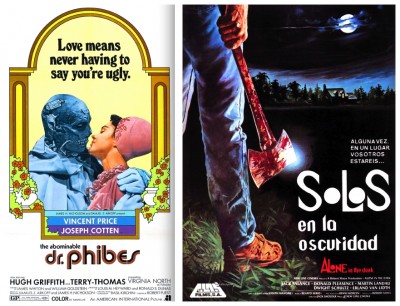 THE ABOMINABLE DOCTOR PHIBES (1971) stars Vincent Price as Anton Phibes, a horribly disfigured genius supposedly killed in a car crash, who is convinced that his beloved wife (Caroline Munro) died a victim of incompetent doctors, and begins to kill them in increasingly elaborate ways, inspired by the biblical plagues of the Pharaohs. Inspector Trout (Peter Jeffrey) suspects Phibes, but finds little support from Scotland Yard. Eventually Doctor Vesalius (Joseph Cotten), the head surgeon that operated on Phibes’s wife, believes Trout and aids him in the hunt for Phibes. The film’s dark humour, art-deco sets and Price’s performance have made the film and its sequel, DOCTOR PHIBES RISES AGAIN (1972) cult classics.
THE ABOMINABLE DOCTOR PHIBES (1971) stars Vincent Price as Anton Phibes, a horribly disfigured genius supposedly killed in a car crash, who is convinced that his beloved wife (Caroline Munro) died a victim of incompetent doctors, and begins to kill them in increasingly elaborate ways, inspired by the biblical plagues of the Pharaohs. Inspector Trout (Peter Jeffrey) suspects Phibes, but finds little support from Scotland Yard. Eventually Doctor Vesalius (Joseph Cotten), the head surgeon that operated on Phibes’s wife, believes Trout and aids him in the hunt for Phibes. The film’s dark humour, art-deco sets and Price’s performance have made the film and its sequel, DOCTOR PHIBES RISES AGAIN (1972) cult classics.
ALONE IN THE DARK (1982) was the directorial debut of Jack Sholder and the very first film to be released by New Line Cinema. Inmates from an experimental insane asylum run by a liberal doctor (Donald Pleasance) escape during an electrical blackout. They terrorise a non-violent asylum doctor (Dwight Schultz) and his family, who barricade themselves in their isolated house. The film begins with a lot of promise before the off-beat humour gives way to ugly violence, the imperiled characters start exhibiting uncommon stupidity and clichéd getaway cars that never start first time. Jack Palance is a highlight as the one redeemable madman, and Carol Levy is a suitably sexy victim. Also stars Martin Landau, Erland Van Lidth, and Deborah Hedwall.
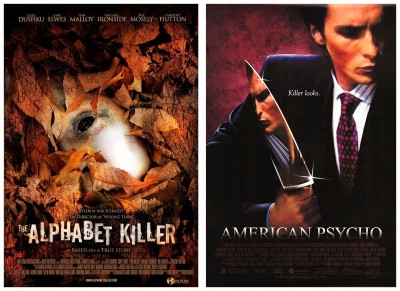 THE ALPHABET KILLER (2008) is loosely based on the so-called Alphabet murders that took place in New York between 1971 and 1973, and stars Eliza Dushku, Cary Elwes, Michael Ironside, Bill Mosely and Timothy Hutton. The film is directed by Rob Schmidt, who made a name for himself with the film WRONG TURN (2003), and written by Tom Malloy, who also plays a character in the film.
THE ALPHABET KILLER (2008) is loosely based on the so-called Alphabet murders that took place in New York between 1971 and 1973, and stars Eliza Dushku, Cary Elwes, Michael Ironside, Bill Mosely and Timothy Hutton. The film is directed by Rob Schmidt, who made a name for himself with the film WRONG TURN (2003), and written by Tom Malloy, who also plays a character in the film.
AMERICAN PSYCHO (2000), based on the novel by Bret Easton Ellis and directed by Mary Harron, focuses on eighties Wall Street yuppy Patrick Bateman (Christian Bale) whose mental instability and bloodlust lead him to serial killing. Predominantly a psychological thriller, the film also features elements of horror, satire and black comedy. Also starring Jared Leto, Josh Lucas, Willem Dafoe and Samantha Mathis, it is one of the few serial killer films to be directed by a female, which is why there were so few complaints made concerning its violent subject matter.
 AMERICAN PSYCHO II (2002) is not a really a sequel but a stand-alone story which started life as a script called THE GIRL WHO WOULDN’T DIE and was stamped with the current title by the producers virtually as an afterthought. Directed by Morgan J. Freeman, it stars Mila Kunis as Rachael Newman, a criminology student who is attracted to murder. Pete Croatto of filmcritic.com wrote, “I can’t think of one AMERICAN PSYCHO fan who wouldn’t be disappointed watching this far inferior sequel, which doesn’t even try to flex any intellectual muscles or take any chances. It’s another stale, kill-by-numbers flick, complete with blade-thin characters and terrible, pun-laden dialogue. And if that’s not enough for you, William Shatner is in it.”
AMERICAN PSYCHO II (2002) is not a really a sequel but a stand-alone story which started life as a script called THE GIRL WHO WOULDN’T DIE and was stamped with the current title by the producers virtually as an afterthought. Directed by Morgan J. Freeman, it stars Mila Kunis as Rachael Newman, a criminology student who is attracted to murder. Pete Croatto of filmcritic.com wrote, “I can’t think of one AMERICAN PSYCHO fan who wouldn’t be disappointed watching this far inferior sequel, which doesn’t even try to flex any intellectual muscles or take any chances. It’s another stale, kill-by-numbers flick, complete with blade-thin characters and terrible, pun-laden dialogue. And if that’s not enough for you, William Shatner is in it.”
AMUSEMENT (2008), directed by John Simpson, concerns a psychopathic stalker known only as The Laugh (Keir O’Donnell) who attacks the now-adult girls who picked on his sick childhood tendencies. Tabitha (Katheryn Winnick), Shelby (Laura Breckinridge) and Lisa Jessica Lucas) become the target of a madman with a serious adolescent grudge.
 AND THEN THERE WERE NONE (1945) is based on the seminal novel by Agatha Christie and has been adapted many times for film, television and stage. The first screen adaptation was in 1945 directed by Rene Clair, the second was two decades later (1965) directed by George Pollock. This film transferred the setting from a remote island to a mountain retreat in Austria. Another two decades passed (1974) when the first colour version of the novel was released, directed by Peter Collinson from a screenplay by Peter Welbeck, who co-wrote the screenplay for the 1965 version. This version was set in a large hotel in Iran. A Russian version was produced with the novel’s original title, Десять негритят (1987), written and directed by Stanislav Govorukhin, and is the only cinema adaptation to use the novel’s original ending. The most recent film, TEN LITTLE INDIANS (1989), directed by Alan Birkinshaw, takes place during a safari in the African savannah.
AND THEN THERE WERE NONE (1945) is based on the seminal novel by Agatha Christie and has been adapted many times for film, television and stage. The first screen adaptation was in 1945 directed by Rene Clair, the second was two decades later (1965) directed by George Pollock. This film transferred the setting from a remote island to a mountain retreat in Austria. Another two decades passed (1974) when the first colour version of the novel was released, directed by Peter Collinson from a screenplay by Peter Welbeck, who co-wrote the screenplay for the 1965 version. This version was set in a large hotel in Iran. A Russian version was produced with the novel’s original title, Десять негритят (1987), written and directed by Stanislav Govorukhin, and is the only cinema adaptation to use the novel’s original ending. The most recent film, TEN LITTLE INDIANS (1989), directed by Alan Birkinshaw, takes place during a safari in the African savannah.
ANTROPOPHAGUS THE BEAST (1980), directed by Joe D’Amato and starring George Eastman, concerns a group of people on a Greek island who begin disappearing or are brutally murdered by a mysterious deformed man. The survivors search for clues as to what is going on, and find a diary inside an abandoned mansion which tells of a man who was shipwrecked with his wife and child. In order to survive, the man was forced to eat his dead family. This act drove him insane and he went on to slaughter the rest of the island’s inhabitants. The cannibalistic serial killer is known as the Antropophagus Beast. The film became one of the infamous titles known in Britain as Video Nasties.
 APRIL FOOL’S DAY (1986) is a Canadian film directed by Fred Walton from a script by Danilo Bach, and concerns eight college friends who gather together at an island mansion belonging to friend Muffy (Deborah Foreman) to celebrate their final year of school. They soon discover that each has a hidden secret from their past which is revealed, and soon after, they turn up dead – or are they? Or is it just part of some very real and cruel April Fool’s jokes? The hostess, Muffy, is the only one who apparently knows what’s going on. Could she be the killer? The original music score composed by Charles Bernstein is a highlight. A direct-to-DVD remake was released in 2008 and, although retaining the original concept, the story and characters are radically altered and contemporised.
APRIL FOOL’S DAY (1986) is a Canadian film directed by Fred Walton from a script by Danilo Bach, and concerns eight college friends who gather together at an island mansion belonging to friend Muffy (Deborah Foreman) to celebrate their final year of school. They soon discover that each has a hidden secret from their past which is revealed, and soon after, they turn up dead – or are they? Or is it just part of some very real and cruel April Fool’s jokes? The hostess, Muffy, is the only one who apparently knows what’s going on. Could she be the killer? The original music score composed by Charles Bernstein is a highlight. A direct-to-DVD remake was released in 2008 and, although retaining the original concept, the story and characters are radically altered and contemporised.
ARE YOU SCARED? (2006), directed by Andy Hurst, concerns six young people who wake up in an abandoned building with no idea of what is going on or how they got there. A mysterious voice is heard over the PA system telling them that they are on a gameshow called ‘Are You Scared?’ and that they will have to face their deepest fears in order to win the contest. However, their challenges are deadly real and one-by-one the group must face their worst fears, risking the highest stakes imaginable. The film involves several contests which all result in the death of the participant: Acid; explosion; shotgun; hungry rats; strangulation; power drill and axe are all featured.
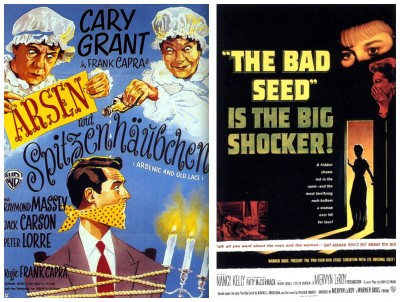 ARSENIC AND OLD LACE (1944) was made by Frank Capra in 1941 but wasn’t released until three years later, after the original stage version had finished its run. Mortimer Brewster (Cary Grant) discovers that insanity runs in his family – it practically gallops. His darling sweet aunts (Josephine Hull & Jean Adair) have been poisoning lonely old men over the years and now have thirteen corpses in the basement. Mortimer frantically tries to keep it a secret but is constantly interrupted by police and his own brother Jonathan (Raymond Massey), an insane killer who has just returned home after committing twelve international murders. Peter Lorre plays a nervous plastic surgeon who, while drunk, accidentally made Jonathan look like Boris Karloff. Much of the humour of the film comes from frustrated characters trying to supply or receive information.
ARSENIC AND OLD LACE (1944) was made by Frank Capra in 1941 but wasn’t released until three years later, after the original stage version had finished its run. Mortimer Brewster (Cary Grant) discovers that insanity runs in his family – it practically gallops. His darling sweet aunts (Josephine Hull & Jean Adair) have been poisoning lonely old men over the years and now have thirteen corpses in the basement. Mortimer frantically tries to keep it a secret but is constantly interrupted by police and his own brother Jonathan (Raymond Massey), an insane killer who has just returned home after committing twelve international murders. Peter Lorre plays a nervous plastic surgeon who, while drunk, accidentally made Jonathan look like Boris Karloff. Much of the humour of the film comes from frustrated characters trying to supply or receive information.
THE BAD SEED (1956) was first a novel by William March published in 1954, then a stage play by Maxwell Anderson, then adapted again by John Lee Mahin for Mervyn LeRoy to direct. Christine Penmark (Nancy Kelly) seems to have it all – a lovely home, a loving husband (William Hopper) and the most perfect daughter in the world (Patty McCormack). But since childhood, Christine has suffered from the most terrible recurring nightmares, and her so-called ‘perfect’ daughter’s accomplishments include lying, stealing and much worse. It was remade in 1985 as a made-for-television movie starring Blair Brown, Lynn Redgrave, David Carradine and Richard Kiley. Eli Roth was set to direct a second remake promising a new take with modern horror sensibilities.
 BASKET CASE (1982), notable for its low budget and over-the-top violence, was written and directed by Frank Henenlotter, and proved so popular that two sequels were produced in 1990 and 1991 by the same director. Charming-but-shy country boy Duane Bradley (Kevin Van Hentenryck) takes a motel room in New York with no other luggage than a basket. In a flashbacks we learn the basket contains his surgically removed Siamese twin brother Belial, who is so physically deformed that the doctors hesitated to even consider him human. It is Belial’s vindictiveness that drives their quest to kill all those he blames but, in the reception of one of those doctors, Duane gets his first ever date, and wants to start a positive life too – when the freak twin escapes, the scene is set for a grim finale.
BASKET CASE (1982), notable for its low budget and over-the-top violence, was written and directed by Frank Henenlotter, and proved so popular that two sequels were produced in 1990 and 1991 by the same director. Charming-but-shy country boy Duane Bradley (Kevin Van Hentenryck) takes a motel room in New York with no other luggage than a basket. In a flashbacks we learn the basket contains his surgically removed Siamese twin brother Belial, who is so physically deformed that the doctors hesitated to even consider him human. It is Belial’s vindictiveness that drives their quest to kill all those he blames but, in the reception of one of those doctors, Duane gets his first ever date, and wants to start a positive life too – when the freak twin escapes, the scene is set for a grim finale.
BEHIND THE MASK: THE RISE OF LESLIE VERNON (2006) is a mockumentary which follows a film crew documenting an aspiring serial killer who models himself according to slasher film conventions. Directed by Scott Glosserman and starring Nathan Baesel, Angela Goethals and Robert Englund, the film was not officially released until 2007.
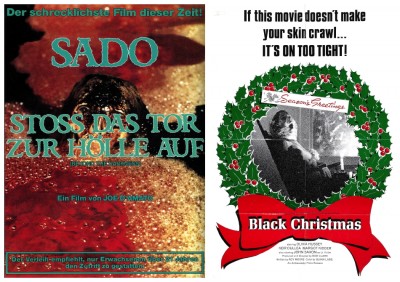 BEYOND THE DARKNESS (1979) aka BUIO OMEGA aka THE FINAL DARKNESS aka BLUE HOLOCAUST was directed by exploitation filmmaker Joe D’Amato. Anna Völkl (Cinzia Monreale) is betrothed to taxidermist Frank Wyler (Keiran Canter) but she passes away while in hospital. She was killed by Frank’s jealous housekeeper, Iris (Franca Stoppi), using a voodoo doll. Stricken with grief, Frank digs up Anna’s body and preserves it so that he can be with his lover forever. He then tries out and disposes of a series of young maidens, trying to find the right replacement for Anna, and the Iris helps him with the disposals. After various detectives search the house, Frank picks up another woman but releases her when Anna’s twin sister Elena arrives. She faints on seeing Anna’s corpse, and Iris attacks her with a knife but Frank intervenes. Iris attacks Frank instead, with Elena’s fate on the line.
BEYOND THE DARKNESS (1979) aka BUIO OMEGA aka THE FINAL DARKNESS aka BLUE HOLOCAUST was directed by exploitation filmmaker Joe D’Amato. Anna Völkl (Cinzia Monreale) is betrothed to taxidermist Frank Wyler (Keiran Canter) but she passes away while in hospital. She was killed by Frank’s jealous housekeeper, Iris (Franca Stoppi), using a voodoo doll. Stricken with grief, Frank digs up Anna’s body and preserves it so that he can be with his lover forever. He then tries out and disposes of a series of young maidens, trying to find the right replacement for Anna, and the Iris helps him with the disposals. After various detectives search the house, Frank picks up another woman but releases her when Anna’s twin sister Elena arrives. She faints on seeing Anna’s corpse, and Iris attacks her with a knife but Frank intervenes. Iris attacks Frank instead, with Elena’s fate on the line.
BLACK CHRISTMAS (1974) is a Canadian slasher film from Bob Clark based on a series of real murders that took place in Quebec during the holiday season, and follows a group of college students who must face a deranged serial killer lurking in their sorority house. Starring Olivia Hussey, Keir Dullea, Margot Kidder, Andrea Martin, Marian Waldman and John Saxon, and inspired by the urban legend known as ‘The Babysitter And The Man Upstairs’, a remake directed by Glen Morgan was released on Christmas day 2006.
 BLOOD FEAST (1963), directed by Herschell Gordon Lewis, is widely considered as the first real ‘splatter film’. An Egyptian caterer kills various women in suburban Miami to use their body parts to bring to life a dormant Egyptian goddess, while inept police detectives try to track him down. The screenplay was written by Alison Louise Downe, who had previously appeared in several of Lewis’ other films. Lewis also composed the film’s music soundtrack. Four decades later a sequel was produced entitled BLOOD FEAST II: ALL U CAN EAT (2002).
BLOOD FEAST (1963), directed by Herschell Gordon Lewis, is widely considered as the first real ‘splatter film’. An Egyptian caterer kills various women in suburban Miami to use their body parts to bring to life a dormant Egyptian goddess, while inept police detectives try to track him down. The screenplay was written by Alison Louise Downe, who had previously appeared in several of Lewis’ other films. Lewis also composed the film’s music soundtrack. Four decades later a sequel was produced entitled BLOOD FEAST II: ALL U CAN EAT (2002).
BLOOD FEAST II: ALL U CAN EAT (2002) is a sequel to the 1963 film directed by Herschell Gordon Lewis. Using the same ‘grindhouse’ style as its predecessor, the film continues the story that began in original film, in which a grandson of Fuad Ramses attempts to restart his uncle’s Egyptian-style catering business.
 BLOOD NIGHT: THE LEGEND OF MARY HATCHET (2009), written and directed by Frank Sabatella, concerns a group of teenagers celebrating the anniversary of the death of the local axe murderer Mary Hatchet, who suddenly find themselves face-to-face with the realities of this haunting urban legend.
BLOOD NIGHT: THE LEGEND OF MARY HATCHET (2009), written and directed by Frank Sabatella, concerns a group of teenagers celebrating the anniversary of the death of the local axe murderer Mary Hatchet, who suddenly find themselves face-to-face with the realities of this haunting urban legend.
BLOOD RAGE (1987) aka NIGHTMARE AT SHADOW WOODS concerns a man accused of committing murders that were actually perpetrated by his evil twin. Written by Bruce Rubin and directed by John Grissmer, it was produced by Marianne Kanter and stars Louise Lasser.
 BLOOD SONG (1982) aka DREAM SLAYER, directed by Robert Angus and Alan J. Levi, concerns a young woman (Donna Wilkes) who witnesses the murder of a hospital attendant by a psychopath during his escape from a mental institution. The young woman, who once was given a blood transfusion from the killer, proves to be his potential next victim. It was released on VHS video by several different companies including Coast-To-Coast Video and eventually released on DVD by BCI Entertainment on a double-bill with MAUSOLEUM (1982), but I believe it’s currently out-of-print.
BLOOD SONG (1982) aka DREAM SLAYER, directed by Robert Angus and Alan J. Levi, concerns a young woman (Donna Wilkes) who witnesses the murder of a hospital attendant by a psychopath during his escape from a mental institution. The young woman, who once was given a blood transfusion from the killer, proves to be his potential next victim. It was released on VHS video by several different companies including Coast-To-Coast Video and eventually released on DVD by BCI Entertainment on a double-bill with MAUSOLEUM (1982), but I believe it’s currently out-of-print.
BLOODMOON (1997), directed by Tony Leung Siu Hong, was produced by Keith W. Strandberg and Ng See Yuen. Ken O’Hara (Gary Daniels), a specialist in serial killers, is enlisted to find a mass murderer (Darren Shahlavi) intent on killing the strongest fighters in New York. Trying to catch this clever killer is the hardest assignment Ken has ever had. Now, the moon is rising again and he must use all of his resources to hunt down the murderer or else he may be the next one to die.
 BLOODSUCKING FREAKS (1976) was shot under the title SARDU: MASTER OF THE SCREAMING VIRGINS then, during its original cinema release, it was retitled THE INCREDIBLE TORTURE SHOW. Based on the Herschell Gordon Lewis film THE WIZARD OF GORE (1970), the film was purchased by Lloyd Kaufman of Troma Entertainment and retitled. Master Sardu and his midget sidekick Ralphus conduct grotesque stage shows about torture and murder. Neither the audiences nor the critics know is that the shows are not staged but real. Furthermore, the naked women who appear to be tortured, dismembered and killed during the performances are not really actresses but kidnapped victims who are made into slaves.
BLOODSUCKING FREAKS (1976) was shot under the title SARDU: MASTER OF THE SCREAMING VIRGINS then, during its original cinema release, it was retitled THE INCREDIBLE TORTURE SHOW. Based on the Herschell Gordon Lewis film THE WIZARD OF GORE (1970), the film was purchased by Lloyd Kaufman of Troma Entertainment and retitled. Master Sardu and his midget sidekick Ralphus conduct grotesque stage shows about torture and murder. Neither the audiences nor the critics know is that the shows are not staged but real. Furthermore, the naked women who appear to be tortured, dismembered and killed during the performances are not really actresses but kidnapped victims who are made into slaves.
BLOODY BIRTHDAY (1981), directed by Ed Hunt, involves three children born in 1970 at the height of a total eclipse. Due to the sun and moon blocking Saturn, which controls emotions, these children become heartless and uncaring with no feelings of remorse. Ten years later they begin to kill the adults around them and are able to escape detection because of their youthful and innocent facades. When a young boy and his older sister discover their crimes, they become targets of the evil children. Two of the evil children are eventually arrested but the girl manages to escape, finishing with the girl promising that she will be a good girl to her mother as they drive away, but the final scene reveals a truck driver who was murdered by the girl.
 BLUEBEARD (1944) was made by people with talent. Indeed, there’s not much wrong with this variation on the old legend of Bluebeard, the serial killer of his own wives, that a decent budget couldn’t have fixed. It has a skilled director, Edgar G. Ulmer, already experienced in doing good work on modest budgets, and the lead is played by John Carradine, an actor of considerable ability, well known to devotees of cheap horror and science-fiction films. In this interpretation of the famous French tale, a strangler of women manages to elude the police.
BLUEBEARD (1944) was made by people with talent. Indeed, there’s not much wrong with this variation on the old legend of Bluebeard, the serial killer of his own wives, that a decent budget couldn’t have fixed. It has a skilled director, Edgar G. Ulmer, already experienced in doing good work on modest budgets, and the lead is played by John Carradine, an actor of considerable ability, well known to devotees of cheap horror and science-fiction films. In this interpretation of the famous French tale, a strangler of women manages to elude the police.
THE BOSTON STRANGLER (1968) was based on the true story of serial strangler Albert DeSalvo (Tony Curtis) who killed at least thirteen women between 1962 and 1964, and police detective John Bottomly (Henry Fonda) who gained fame for finally obtaining DeSalvo’s confession. The first part of the film shows the police investigation, with some examples of the seedier side of Boston life, including promiscuity in the adult quarters of the city. The second part shows the apprehension of DeSalvo. The intention of Bottomly and the law is to answer the question presented on the film’s posters: Why did thirteen women open their doors to the Boston Strangler?
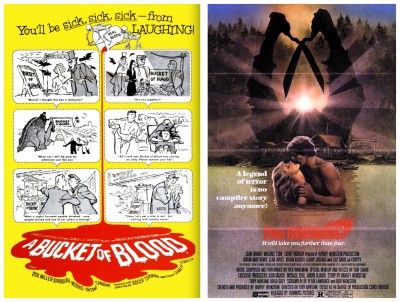 A BUCKET OF BLOOD (1959) is a black comedy written by Charles B. Griffith and directed by Roger Corman, starring Dick Miller as Walter Paisley, a socially awkward young busboy at a bohemian café who is acclaimed as a brilliant sculptor when he accidentally kills his landlady’s cat and covers its body in clay to hide the evidence. When he is pressured to create similar work, he becomes murderous and subsequently crazed with guilt.
A BUCKET OF BLOOD (1959) is a black comedy written by Charles B. Griffith and directed by Roger Corman, starring Dick Miller as Walter Paisley, a socially awkward young busboy at a bohemian café who is acclaimed as a brilliant sculptor when he accidentally kills his landlady’s cat and covers its body in clay to hide the evidence. When he is pressured to create similar work, he becomes murderous and subsequently crazed with guilt.
THE BURNING (1981) tells the story of a cruel and sadistic alcoholic caretaker at a summer camp, nicknamed ‘Cropsy’ because of the huge garden shears he uses. The caretaker falls victim to a prank that went out of control and leaves him horribly burned and disfigured. Following his release from hospital, he returns to his old stomping ground and begins a murder spree. Directed by Tony Maylam with music by Rick Wakeman, it was one of the very first Miramax movies, produced by Harvey Weinstein with a script co-written by brother Bob Weinstein.
 CAMP BLOOD (2000), written and directed by Brad Sykes, involves four hikers out and about on a camping trip in the woods without a care, who soon find themselves in an unknown world. With the death of their guide and at the mercy of a cold blooded killer, the trip of fun in the sun soon takes a wrong turn. With friends disappearing one-by-one, so do the chances of getting out alive. It proved popular enough to warrant two sequels, BLOOD CAMP II (2000) and WITHIN THE WOODS (2005).
CAMP BLOOD (2000), written and directed by Brad Sykes, involves four hikers out and about on a camping trip in the woods without a care, who soon find themselves in an unknown world. With the death of their guide and at the mercy of a cold blooded killer, the trip of fun in the sun soon takes a wrong turn. With friends disappearing one-by-one, so do the chances of getting out alive. It proved popular enough to warrant two sequels, BLOOD CAMP II (2000) and WITHIN THE WOODS (2005).
CAPTIVITY (2007), directed by Roland Joffe and based on a screenplay by Larry Cohen and Joseph Tura, centres on two people who have been abducted and driven mad. In New York fashion model Jennifer (Elisha Cuthbert) is drugged in a Soho nightclub and kidnapped with her dog. Jennifer awakes in a cell in a basement and is submitted to psychological and physical tortures by her twisted abductor. When she meets Gary (Daniel Gillies) on the next cell, the stranger protects her and she feels attracted to him. When they manage to escape from their imprisonment, Jennifer discovers the truth about her sick kidnapper.
 CASTLE FREAK (1995), directed by Stuart Gordon, is loosely based on the H.P. Lovecraft story The Outsider. After inheriting a twelfth century Italian castle once owned by a famous Duchess, John Reilly (Jeffrey Combs) and his family move in. What they don’t know is the duchess’ son still lives in the dungeons of the castle. He breaks free, intending to attack John and his family, and killing others in the process. John must now save himself and his family from this castle’s unknown inhabitant before the ‘castle freak’ has his way with them.
CASTLE FREAK (1995), directed by Stuart Gordon, is loosely based on the H.P. Lovecraft story The Outsider. After inheriting a twelfth century Italian castle once owned by a famous Duchess, John Reilly (Jeffrey Combs) and his family move in. What they don’t know is the duchess’ son still lives in the dungeons of the castle. He breaks free, intending to attack John and his family, and killing others in the process. John must now save himself and his family from this castle’s unknown inhabitant before the ‘castle freak’ has his way with them.
THE CELL (2000), directed by Tarsem Singh, concerns psychologist Catherine Deane (Jennifer Lopez), an expert in an experimental treatment for coma patients, using a device that allows her to enter the minds of her patients and coax them into consciousness. An FBI agent recruits her to enter the mind of a comatose serial killer (Vincent D’Onofrio) in order to learn where he has hidden his latest kidnap victim.
 CHERRY FALLS (2000), written by Ken Selden and directed by Geoffrey Wright, takes place in the small town of Cherry Falls, Virginia, where a black-clad long-haired killer is offing various high school teenage virgins in various gory ways. Jody Marken (Brittany Murphy), the virginal teenage daughter of the town’s sheriff (Michael Biehn), launches her own investigation to figure out the killer’s identity and stumbles into a web of long hidden dark secrets spun around the killings involving people of the town she always thought she trusted which makes her one of the killer’s primary targets.
CHERRY FALLS (2000), written by Ken Selden and directed by Geoffrey Wright, takes place in the small town of Cherry Falls, Virginia, where a black-clad long-haired killer is offing various high school teenage virgins in various gory ways. Jody Marken (Brittany Murphy), the virginal teenage daughter of the town’s sheriff (Michael Biehn), launches her own investigation to figure out the killer’s identity and stumbles into a web of long hidden dark secrets spun around the killings involving people of the town she always thought she trusted which makes her one of the killer’s primary targets.
CHRISTMAS EVIL (1980) aka YOU BETTER WATCH OUT aka TERROR IN TOYLAND is an obscure black comedy written and directed by Lewis Jackson which has gained a cult following, and is a favourite of legendary filmmaker John Waters. A boy learns that Santa Claus is not real and, for the rest of his life, tries to make the Christmas spirit a reality. He becomes obsessed with the behaviour of children and the quality of the toys he makes. When he is met with hypocrisy and cynicism, the resulting snap causes him to go on a yuletide killing spree dressed as Santa Claus.
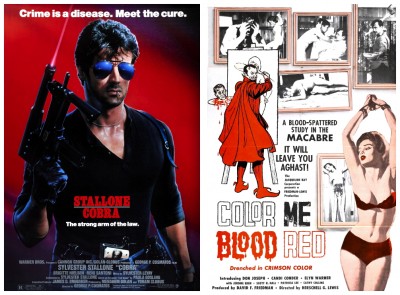 COBRA (1986), loosely based on the novel Fair Game by Paula Gosling, was a box-office hit but a failure with critics. A gang of neo-fascist thugs, led by the self-proclaimed Night Slasher (Brian Thompson), are breaking into people’s homes and cars, then killing them seemingly at random. When one of these thugs holds up a food store and takes hostages, no-nonsense police lieutenant Marian Cobretti (Sylvester Stallone) is called in to end the hostage-taking. Originally written by Stallone for BEVERLY HILLS COP (1984), the script was rejected as being too dark when comedy actor Eddie Murphy was signed to star.
COBRA (1986), loosely based on the novel Fair Game by Paula Gosling, was a box-office hit but a failure with critics. A gang of neo-fascist thugs, led by the self-proclaimed Night Slasher (Brian Thompson), are breaking into people’s homes and cars, then killing them seemingly at random. When one of these thugs holds up a food store and takes hostages, no-nonsense police lieutenant Marian Cobretti (Sylvester Stallone) is called in to end the hostage-taking. Originally written by Stallone for BEVERLY HILLS COP (1984), the script was rejected as being too dark when comedy actor Eddie Murphy was signed to star.
COLOR ME BLOOD RED (1965), written and directed by Herschell Gordon Lewis, is considered by many fans as the third in the filmmaker’s ‘Blood’ trilogy, beginning with BLOOD FEAST (1963) and 2000 MANIACS! (1964). An eccentric artist is panned by a well-known critic at his opening for not having a good colour sense, so he starts a new series, using his own blood as paint. Soon he is weakened and must find other sources of blood to continue his paintings.
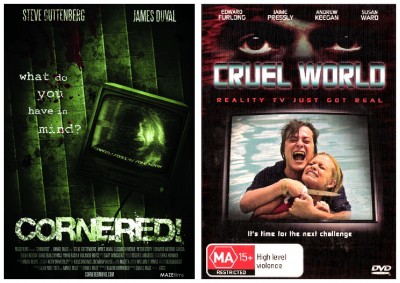 CORNERED! (2009), written and directed by Daniel Maze, concerns a group of low-life friends playing poker in a liquor store who, after discussing a string of recent brutal murders committed at liquor stores, gets locked in. Unable to find the keys to escape, the group talks about collecting the bounty placed on the serial killer’s head but, as the night wears on, the group’s number falls as the killer stalks them one-by-one.
CORNERED! (2009), written and directed by Daniel Maze, concerns a group of low-life friends playing poker in a liquor store who, after discussing a string of recent brutal murders committed at liquor stores, gets locked in. Unable to find the keys to escape, the group talks about collecting the bounty placed on the serial killer’s head but, as the night wears on, the group’s number falls as the killer stalks them one-by-one.
CRUEL WORLD (2005), directed by Kelsey T. Howard, focuses on a psychotic man who loses on a reality television show. After he kills the show’s host he then uses the house where the show took place to film his own reality show, which involves several contestants performing challenges, and the losers are ‘sent home’, a euphemism for being killed off.
 CURFEW (1989), directed by Gary Winick, concerns two escaped brothers (Wendell Wellman & John Putch) who track down the people who sentenced them to death row, including a doctor and the judge. They have an especially lengthy revenge plot in mind for the District Attorney and his family.
CURFEW (1989), directed by Gary Winick, concerns two escaped brothers (Wendell Wellman & John Putch) who track down the people who sentenced them to death row, including a doctor and the judge. They have an especially lengthy revenge plot in mind for the District Attorney and his family.
CUT (2000), an Australian film directed by Kimble Rendall and starring Molly Ringwald, Kylie Minogue and Tiriel Mora, concerns a group of film students who attempt to finish a horror movie that stopped production years earlier when the director was killed. Unaware that every attempt to complete the film coincided with the murders of those involved, the students return to the original location in an isolated part of the country. When filming begins, so do the killings.
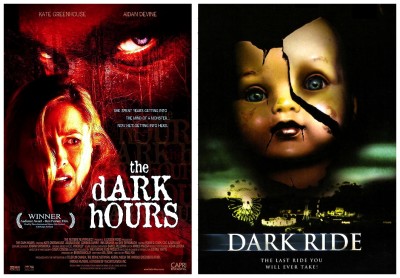 THE DARK HOURS (2005), directed by Paul Fox from a script by Wil Zmak, is cited as the biggest film failure of the year with a total gross of $423.00. The film isn’t really that bad, the poor earnings were due to poor marketing and distribution. Psychiatrist Samantha Goodman (Kate Greenhouse) has an incurable brain tumor and, suffering from stress, decides to spend the weekend in her cottage with her husband and her sister. She unexpectedly arrives at the cabin and finds a bottle of champagne in the refrigerator. Later, a young man named Adrian (Dov Tiefenbach) asks for help due to the cold weather and, once in the house, he reveals a gun and brings in his partner Harlan (Aidan Devine), a violent sexual offender and Samantha’s former patient. Through the night Harlan forces the family to participate in twisted games, where truths are disclosed.
THE DARK HOURS (2005), directed by Paul Fox from a script by Wil Zmak, is cited as the biggest film failure of the year with a total gross of $423.00. The film isn’t really that bad, the poor earnings were due to poor marketing and distribution. Psychiatrist Samantha Goodman (Kate Greenhouse) has an incurable brain tumor and, suffering from stress, decides to spend the weekend in her cottage with her husband and her sister. She unexpectedly arrives at the cabin and finds a bottle of champagne in the refrigerator. Later, a young man named Adrian (Dov Tiefenbach) asks for help due to the cold weather and, once in the house, he reveals a gun and brings in his partner Harlan (Aidan Devine), a violent sexual offender and Samantha’s former patient. Through the night Harlan forces the family to participate in twisted games, where truths are disclosed.
DARK RIDE (2006), directed by Craig Singer and written by Robert Dean Klein, was selected to screen at the Eight Films To Die For film festival, and revolves around a group of six friends who are terrorised by an escaped mental patient at an amusement park attraction called Dark Ride.
 DEATH PROOF (2007), written and directed by Quentin Tarantino, focuses on a psychopathic movie stuntman (Kurt Russell) who stalks young women before murdering them in staged car accidents using his ultra-safe ‘death proof’ car. The film was released theatrically as part of a double-feature with Robert Rodriguez’s PLANET TERROR (2007) under the collective title ‘Grindhouse’ in an attempt to recapture the experience of viewing exploitation double-features during the seventies.
DEATH PROOF (2007), written and directed by Quentin Tarantino, focuses on a psychopathic movie stuntman (Kurt Russell) who stalks young women before murdering them in staged car accidents using his ultra-safe ‘death proof’ car. The film was released theatrically as part of a double-feature with Robert Rodriguez’s PLANET TERROR (2007) under the collective title ‘Grindhouse’ in an attempt to recapture the experience of viewing exploitation double-features during the seventies.
DEATH SCREAMS (1983) aka NIGHT SCREAMS aka HOUSE OF DEATH, directed by David Nelson, involves a group of locals celebrating the last night of Carnivale who decide to spend the night down by the river, where a double homicide took place several nights before. Among them is the killer responsible for the deaths who, troubled over a tragic past, decides to take their frustrations out with a machete on those thought to be responsible for all their misfortunes. Following the group back to the riverside, the killer ensures that no one leaves the area alive.
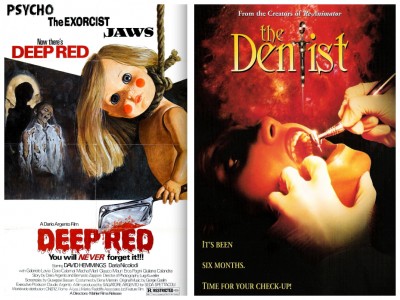 DEEP RED (1975) aka THE HATCHET MURDERS, written and directed by Dario Argento, and stars David Hemmings as a music teacher who investigates a series of murders performed by a mysterious figure wielding a hatchet. Although the film was not a financial success internationally, the film has met with critical acclaim over the years, and has garnered a strong cult following.
DEEP RED (1975) aka THE HATCHET MURDERS, written and directed by Dario Argento, and stars David Hemmings as a music teacher who investigates a series of murders performed by a mysterious figure wielding a hatchet. Although the film was not a financial success internationally, the film has met with critical acclaim over the years, and has garnered a strong cult following.
THE DENTIST (1996), directed by Brian Yuzna and written by Dennis Paoli, stars Corbin Bernsen as Doctor Alan Feinstone, a successful dentist with a beautiful wife, a huge house, and a job he’s good at. That is, until he finds out that his wife is having an affair with the pool boy, and now his mind has snapped. Any plaque, tooth decay, or bad breath can set off his mind, and now if you have a trip to the dentist, you better cancel it, unless you want to be dentally tortured. The film was inspired by the story of real-life dentist/serial killer Nick Rex. The sequel, THE DENTIST II (1998) also starred Corbin Bernsen as the titular doctor.
 DERANGED (1974), directed by Alan Ormsby and Jeff Gillen, is a low-budget movie that has developed quite a cult following, being somewhat faithful to the legend of one the most infamous of all serial killers, Ed Gein. Ezra Cobb (Roberts Blossom) lives with his mother in Midwest USA with his mother, a religious fanatic who has indoctrinated Ezra since childhood to hate women. Soon after her funeral, Ezra digs her up again, believing that she’s still alive. Ever more deluded each passing day, Ezra digs up various bodies, restoring them from their decomposition and even using them as home decor. Soon, Ezra’s obsessions go beyond the dead themselves, and he becomes a serial killer, luring women into his grasp. He soon finds various other creative ways in which to decorate his home.
DERANGED (1974), directed by Alan Ormsby and Jeff Gillen, is a low-budget movie that has developed quite a cult following, being somewhat faithful to the legend of one the most infamous of all serial killers, Ed Gein. Ezra Cobb (Roberts Blossom) lives with his mother in Midwest USA with his mother, a religious fanatic who has indoctrinated Ezra since childhood to hate women. Soon after her funeral, Ezra digs her up again, believing that she’s still alive. Ever more deluded each passing day, Ezra digs up various bodies, restoring them from their decomposition and even using them as home decor. Soon, Ezra’s obsessions go beyond the dead themselves, and he becomes a serial killer, luring women into his grasp. He soon finds various other creative ways in which to decorate his home.
DIRTY HARRY (1971), directed by Don Siegel and starring Clint Eastwood in his first outing as San Francisco Police Inspector ‘Dirty’ Harry Callahan. Scorpio (Andrew Robinson) is a psycho nut-job who announces that he’ll kill a hapless citizen every day until he gets…one hundred thousand dollars! Playing to the fears and sympathies of the population, Scorpio stirs-up Callahan, kills innocents, kidnaps children and even pretends to be the victim of police brutality. Callahan and his sidekick do their best against all the red tape and interference from the Mayor (John Vernon) and Police Chief. Forced to go outside his own strict morals to capture Scorpio, Callahan finally plugs the bad guy, then throws his police badge into a puddle.
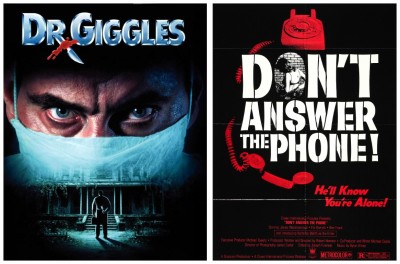 DOCTOR GIGGLES (1992) concerns the psychopathic son of a mass-murdering doctor who escapes from his mental institution to seek revenge on the town where his father was caught. The giggling doctor kills his victims with a surgical theme. His goal being to give one of the townsfolk a heart transplant. Directed by Manny Coto and starring Larry Drake as the titular antagonist, the film also stars Holly Marie Combs, Cliff De Young and Glenn Quinn.
DOCTOR GIGGLES (1992) concerns the psychopathic son of a mass-murdering doctor who escapes from his mental institution to seek revenge on the town where his father was caught. The giggling doctor kills his victims with a surgical theme. His goal being to give one of the townsfolk a heart transplant. Directed by Manny Coto and starring Larry Drake as the titular antagonist, the film also stars Holly Marie Combs, Cliff De Young and Glenn Quinn.
DON’T ANSWER THE PHONE! (1980), written and directed by Robert Hammer, concerns Vietnam veteran and photographer Kirk (Nicholas Worth) who becomes a crazed killer stalking the streets of Los Angeles, picking up young women and strangling them in lurid fashion. He repeatedly contacts radio psychologist Lindsay Gale (Flo Lawrence). He targets Doctor Gale’s patients, commits a murder while on the phone to her show – forcing her to listen to the victim’s cries – and eventually goes after Doctor Gale herself. Meanwhile the killer is being tracked by a pair of inept police detectives.
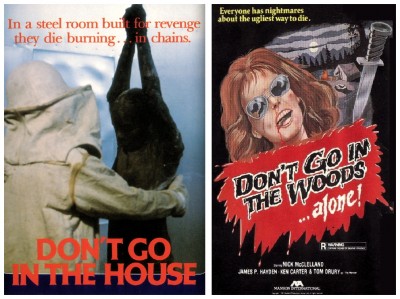 DON’T GO IN THE HOUSE (1980) aka PYROMANIAC gained notoriety as a Video Nasty in the United Kingdom and remains banned in some countries. Donald Kohler (Dan Grimaldi) is a young man who, as a child, was severely burned by his sadistic overbearing mother as a cruel means of discipline and punishment. After years of social estrangement pass, Donald comes home after an accident, only to find that his mother died in her sleep. Donald tries to ease his repression by seeking out women who look like his mother, bringing them home, hanging them in a steel-plated room and burning them alive with a flamethrower.
DON’T GO IN THE HOUSE (1980) aka PYROMANIAC gained notoriety as a Video Nasty in the United Kingdom and remains banned in some countries. Donald Kohler (Dan Grimaldi) is a young man who, as a child, was severely burned by his sadistic overbearing mother as a cruel means of discipline and punishment. After years of social estrangement pass, Donald comes home after an accident, only to find that his mother died in her sleep. Donald tries to ease his repression by seeking out women who look like his mother, bringing them home, hanging them in a steel-plated room and burning them alive with a flamethrower.
DON’T GO IN THE WOODS (1981), directed by James Bryan, concerns four young campers back-packing through the mountains, while someone else is killing tourists in the woods. The hills are alive with overweight people huffing up hillsides, nerdy bird-watchers and young couples, most of whom meet a gruesome end at the hands of a deranged woodsman. Our happy campers get lost in the forest which becomes denser and darker as they progress. Something large suddenly comes lunging forward with a gleaming machete, and the rest of the day and terrifying night is spent running and hiding from the maniac murderer in constant pursuit.
 DON’T OPEN TILL CHRISTMAS (1984), directed by and starring Edmund Purdom, concerns a serial killer running loose through the streets of London hunting down men dressed as Santa and killing them in various violent ways. Inspector Harris (Edmund Purdom) takes on the unenviable task of tracking down the psychopath, but he has his work cut out for him. Only the suspicious reporter Giles (Alan Lake) seems to offer the Inspector any promising leads. Don’t blink or else you’ll miss actress Caroline Munro, whose scenes were filmed in a single afternoon.
DON’T OPEN TILL CHRISTMAS (1984), directed by and starring Edmund Purdom, concerns a serial killer running loose through the streets of London hunting down men dressed as Santa and killing them in various violent ways. Inspector Harris (Edmund Purdom) takes on the unenviable task of tracking down the psychopath, but he has his work cut out for him. Only the suspicious reporter Giles (Alan Lake) seems to offer the Inspector any promising leads. Don’t blink or else you’ll miss actress Caroline Munro, whose scenes were filmed in a single afternoon.
DRESSED TO KILL (1980), directed by Brian DePalma, plunges the viewer headfirst into an erotic cloud as frustrated housewife Kate Miller (Angie Dickinson) fantasises while she’s actually enduring one of her husband’s wham-bammers. Later, the unhappy Kate recounts her woes to trendy Manhattan therapist (Michael Caine), but that afternoon she’s even more guilt-ridden after some torrid rumpy-pumpy in a taxi cab with a handsome stranger she picked up whilst cruising an art museum. Things turn particularly nasty when, in true PSYCHO (1960) style, our lead character is viciously murdered mid-film in an elevator. Hooker Liz Blake (Nancy Allen) then becomes the film’s new lead after witnessing Kate’s gruesome murder. As the prime suspect of hard-assed cop Marino (Dennis Franz), Liz teams up with Kate’s whiz-kid son (Keith Gordon) and together they set out to catch the killer.
 THE DRILLER KILLER (1979), starring and directed by Abel Ferrara, concerns a New York painter named Reno (Abel Ferrara) who shares a loft with his girlfriend Carol (Carolyn Marz). When a rock band moves into his building playing day and night, Reno is driven insane by insomnia and wanders the streets with a power drill, killing homeless derelicts. His girlfriend soon leaves him and, after his art dealer dismisses his work, Reno goes right over the edge. This was yet another film placed on the United Kingdom’s list of Video Nasties.
THE DRILLER KILLER (1979), starring and directed by Abel Ferrara, concerns a New York painter named Reno (Abel Ferrara) who shares a loft with his girlfriend Carol (Carolyn Marz). When a rock band moves into his building playing day and night, Reno is driven insane by insomnia and wanders the streets with a power drill, killing homeless derelicts. His girlfriend soon leaves him and, after his art dealer dismisses his work, Reno goes right over the edge. This was yet another film placed on the United Kingdom’s list of Video Nasties.
DRIVE-IN MASSACRE (1976), directed by Stu Segall, begins with a young couple arriving at a local run-down drive-in theatre. They park their car and talk about having a baby. The woman suggests procreating at the drive-in but the man, Alan, wants to see the beginning of the movie. As he reaches out for the speaker to hang upon the car window, he is beheaded by a sword-like machete. The woman screams, but the unseen killer shoves the blade through her neck and she dies a slow death as she opens the car door and falls out onto the ground. Three interesting things: 1. You never actually see the film showing at the drive-in. 2. The killer gets away. 3. The score sounds like it was composed by throwing a Casio keyboard down a flight of stairs.
 DUEL (1971), directed by Steven Spielberg, involves a man (Dennis Weaver) driving cross-country who is attacked repeatedly by a truck he has overtaken. Although the driver of the truck is never seen in full, we see his boots, his hat, his arm – he is most definitely a man, a crazy road-raged man at that. The film has virtually no dialogue, it is pure cinema brilliantly edited, about an ordinary man (like most of Spielberg’s heroes) being driven to the brink of madness by a violent attack out of no-where.
DUEL (1971), directed by Steven Spielberg, involves a man (Dennis Weaver) driving cross-country who is attacked repeatedly by a truck he has overtaken. Although the driver of the truck is never seen in full, we see his boots, his hat, his arm – he is most definitely a man, a crazy road-raged man at that. The film has virtually no dialogue, it is pure cinema brilliantly edited, about an ordinary man (like most of Spielberg’s heroes) being driven to the brink of madness by a violent attack out of no-where.
EATEN ALIVE (1977), directed by Tobe Hooper, is concerned with the owner of swamp-bound hotel who has a terrible habit of feeding his guests to his pet crocodile. Its incredible genre cast is the primary reason for the film’s cult status, which includes Neville Brand, Robert Englund, Roberta Collins, William Finley, Marilyn Burns, Carolyn Jones, Mel Ferrer and others.
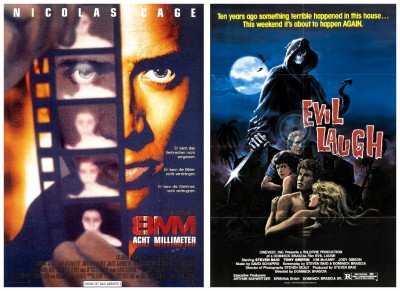 8MM (1999), directed by Joel Schumacher, stars Nicolas Cage as private investigator Tom Welles who delves into the world of snuff movies. He seeks justice for a girl who was killed while being filmed by tracing and eventually killing the filmmakers involved. Finally he tracks down the actual killer, a man only known as Machine (Chris Bauer), a bespectacled bald man named George. He says, “What did you expect? A monster?” and confesses that he has no ulterior motive for his sadistic actions, he does them simply because he enjoys it.
8MM (1999), directed by Joel Schumacher, stars Nicolas Cage as private investigator Tom Welles who delves into the world of snuff movies. He seeks justice for a girl who was killed while being filmed by tracing and eventually killing the filmmakers involved. Finally he tracks down the actual killer, a man only known as Machine (Chris Bauer), a bespectacled bald man named George. He says, “What did you expect? A monster?” and confesses that he has no ulterior motive for his sadistic actions, he does them simply because he enjoys it.
EVIL LAUGH (1986), written and directed by Dominick Brascia, involves an old orphanage which was mysteriously burned to the ground following accusations of child molestation and abuse. Ten years later a group of medical students are brought in by a seemingly benevolent doctor turned pediatrician, Jerry, who wants to fix the place up as a foster home. Soon the students discover that Jerry has been disposed of by an intruder who is still lurking close by. The staff may find themselves joining their dearly departed doctor sooner than they’d like, when the intrusive killer makes a return visit.
 Horror News | HNN Official Site | Horror Movies,Trailers, Reviews
Horror News | HNN Official Site | Horror Movies,Trailers, Reviews
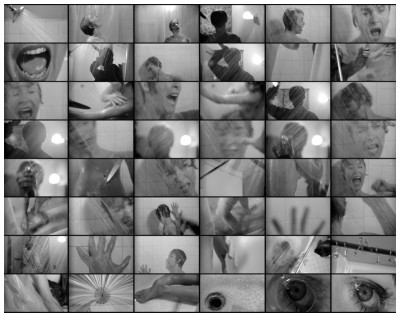
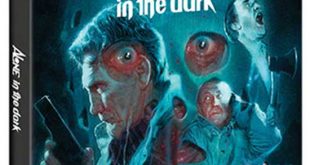
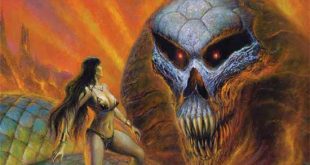


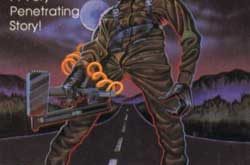
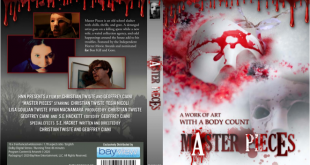
The creation such monsters helps society cope with the darker side of humanity but, arguably, may also lead to desensitisation towards violence.
These sorts of films deal with the violation of bodies, of minds, of normality, but very few of these films implicitly invited the audience to join with the oppressor, the violator, the villain. My old friend, author Gene Wolfe, told me back in 1985, “I think that all of us have a desire to experience the worst so that we can tell ourselves that we can survive the worst. That is part of the appeal of horror.” The audiences of graphic horror films may be quite innocent of sadism. They are voluntarily undertaking a kind of rite-of-passage, which is just as likely to be as cleansing and cathartic as it is to be corrupting. The entertainment to be derived from these films need not be sick – the source of the entertainment is our knowledge that the events we are witnessing are a fiction, just as riding a roller-coaster is not the same as actually plunging off a cliff. Our relief at this, along with the knowledge that we can go home afterwards and have a glass of Absinthe, constitutes a major part of of our response. For this reason, most so-called Video Nasties – very obviously fictions – should not be categorised in the same pigeonhole as certain Video Nasties presented in the realist mode.
OK….. What happened to the film Chained, starring Vincent D’Onofrio ? That film is AMAZING…
I don’t think it was based on a real case, but it was a brilliant film !!!!!!! And it was directed by Jennifer Lynch, David’s daughter !!!!
Hello, good evening and thanks for reading! There’s a very good reason Chained (2012) is not listed. Chained was screened at festivals in August 2012 but did not receive a cinematic release. It went straight to video/DVD in the USA in October, less than two months before I posted this article. I simply didn’t know about it. If I ever update this list, I’ll be sure to include Chained. I like Jennifer Lynch’s work so far, and Vincent D’Onfrio is a terrific actor not afraid of more bizarre roles.
make scream 5 bob weinstein everyone wants it i certinely do keep more twists and surprises in scream 5 and make a scream 6 aswell
HELP!!! me find a movie. Serial killer with a companion;possibly B&W; Waren Oates comes to mind(looks); Brutal rape scene (and strangling) middle aged woman,anal rape;saw on late night show years ago. So nast y that it left an impression, now it’s driving me mad trying to locate. Thanks
Trying to get the name of the pre-60s movie where a serial killer guy use women to make new species of roses
Nigel, thank you for this comprehensive list. Definitely added a few titles to my queue. Most notably Dr. Phibes. Also added a different hue to horror, comedy, their blending points and catharsis.